 Mini Review
Mini Review
Recent Topics on Sophisticated Polymer Compounding Techniques Using Twin Screw Extrusion
Tadamoto Sakai*
Organization for Innovation & Social Collaboration, Shizuoka University, Hamamatsu City, Shizuoka, Japan
Tadamoto Sakai, Organization for Innovation & Social Collaboration, Shizuoka University, 3-5-1 Johoku, Naka-Ku, Hamamatsu City, Shizuoka,432-8011, Japan.
Received Date: October 13, 2022; Published Date: October 20, 2022
Abstract
Polymer compounding technology using a twin-screw extruder is playing greatly important roles both in development and in production for various functional polymer composites and polymer-alloys with complicated or diversified morphology. In this review recent fabulous progresses in sophisticated compounding techniques were introduced from the practical point of view. As practical examples to show excellent product performance, three kinds of compounding technology utilized with innovative polymer blending and inorganic nano-filler mixing using twin screw extrusion were selected.
Keywords:Twin screw extruder; Compounding; Nano-filler; Polymer alloy; Composite; Morphology; Devolatilization
Abbreviations:CNT=Carbon nanotube; GOPTS=Glycidyl propyl-trimethoxy-silane; m-EBR: Maleic anhydride modified ethylene–butene rubber copolymer; NC=Nanoclay; NR= Natural rubber; PA=Polyamide; PC=Polycarbonate; PhOH=Phenolic resin; PLA=Polylactic acid; PP= Polypropylene; PPS=Polyphenylene sulfide; TEM=Transmission electron microscope; TPV=Thermoplastic vulcanizate; TSOP=Toyota super polyolefin (PP/rubber/ talc blends)
Introduction
A twin-screw extruder is used for the creation of the
functionalization and reinforcement of various polymers
and fillers as shown below.
• Mixing and compounding of diversified fillers, fibres and
additives.
• Morphology control of polymer alloys and composites.
• Chemical reactions of polymers, monomers, and additives.
• Devolatilization for solvent, water and by-products
• Dewatering from polymer latex or slurry.
The main advantages of a twin-screw extruder are to be able to obtain higher additional-value products and better productivity, when other mixing devices are compared. In particular, the number of operational parameters of a twin-screw extruder are much increased in number than those of a batch type internal mixer or a single screw extruder. This means the flexibility and the multiplicity in compounding operations are obtainable, if a twin-screw extruder is used. So many technical papers have been published on compounding technology concerning high performance polymer alloys and polymer nanocomposites in recent years. From these papers three kinds of innovative compounding examples used with twin screw extrusion techniques were picked up in this review from the practical point of view.
A New Compounding Technique (1) for CNT Composites having Characteristic Properties
CNT is an expensive material and therefore is requested to reduce amount of the addition as low as possible. One of the ways to reduce the addition of CNT is the utilization of morphology control of a polymer-alloy after pre-blending CNT with a polymer which is easy to disperse. In addition to this demand, K. Fukumori et al reported a new technique that can control together with thermal conductivity, mechanical properties and electrical insulating properties of CNT reinforced polymer-composites at the same time by using complicated morphology manipulation by twin screw extrusion [1]. When high conductive-CNT is used, it is normal that the thermal conductivity is much improved, but electrical insulating properties are not able to maintain. However, a product with high thermal-conductivity, keeping with highly electric-insulating properties, is requested in the special application market. Figure 1 shows the composite morphology changes to overcome such contradicting requirements. The composite was obtained by stepwise compounding processes controlling polymer-alloy morphology composed of PA 6, PPS, CNT and GOPTS. The following is a procedure how to obtain polymer blends with high thermal conductivity, keeping with high electrical insulating properties and high elastic-modulus. First, the PPS domain of nano-size was formed in the PA matrix contained with CNT by the melt-blending operation of twin-screw extrusion. Second, PA/PPS/CNT blends with high thermal conductivity and high mechanical strength were produced by using GOPTS, i.e. a reactive shell structure forming agent to encapsulate each edge of CNT, while electrical insulating properties were maintained. Figure 2 shows the comparisons of electrical insulation properties and thermal conductivity of various PA/PPS/CNT composites. In case of the composite shown as “f” in Figure 2, highly thermal conductivity and highly mechanical properties were simultaneously improved, while highly electrical insulation properties were still maintained.
Figure 1:A new compounding process to control together with thermal conductivity, elastic modulus and electrical insulation properties by sophisticated morphology control of PA/PPS/CNT composites.
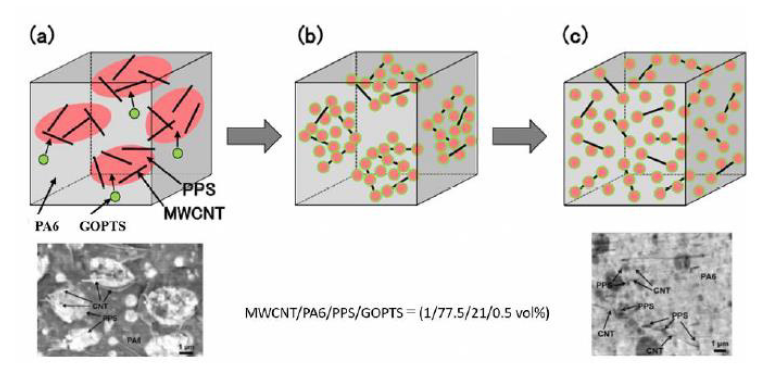
Figure 2:Thermal conductivity and electrical insulation of various PA/PPS/CNT composites.
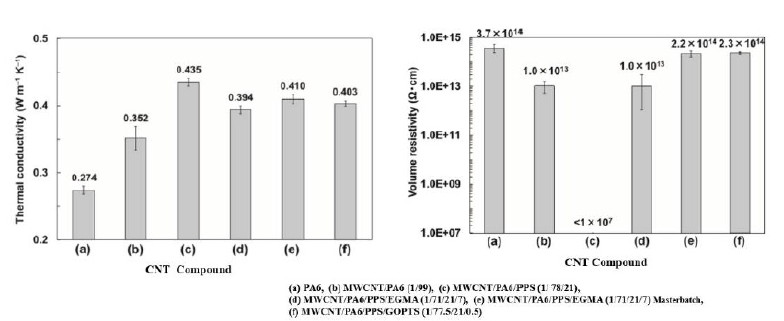
A New Compounding Technique (2) for Polymer- Alloys having Complicated Phase-Morphology
Not only the creation of polymer composites filled with nanosize inorganic additives is becoming popular, but also, the creation of polymer-alloys with nano-level morphology is progressed under the technical advancements in a twin-screw extruder with high mixing capability and proper compatibilizer selection. Figure 3 shows an example to attempt drastic improvement in mechanical properties of a polymer-alloy by complex morphology formation developed by J. Kawada, et al [2]. Biobased-PA-11 and PP were mixed with a reactive compatibilizer, m-EBR, using a twin-screw extruder. In this case, the morphology of a polymer-alloy composed of PA- 11 and PP was precisely controlled to obtain higher mechanical strength. Usually, simple compounding together with PA11 and PP leads to the “sea-island” structure, which shows not so high impact strength. Therefore, in the first stage, PA-11/PP polymer-alloy with “nano-salami” structure was produced to obtain higher mechanical strength than that of “sea-island” structure. Furthermore, in the next stage PA-11/PP polymer-alloy with “co-continuous” morphology was produced to perform the highest mechanical strength by using the reactive compatibilizer m-EBR. The compatibilizers played a key role in forming the special morphology and then improving impact strength, as well as mixing capabilities of a twin-screw extruder. The morphology observations by TEM revealed that the reactive compatibilizers were in the interphase between the matrix and the dispersed phase.
Figure 3 shows the difference of each morphology and related mechanical properties. Two kinds of PA-11/PP polymer-alloys exhibited much superior mechanical properties, when compared with PA-11/PP polymer-alloy having “sea-island” structure that was created using a conventional compounding procedure. Furthermore, it is clear that the mechanical properties of these PA-11/PP polymer-alloys with nano-salami and co-continuous structures were better than those of PP composites, so-called “TSOP”, which are widely used in the car industry.
Figure 3:Improvements in impact strength of PA-11/PP polymer-alloys produced by morphology control.
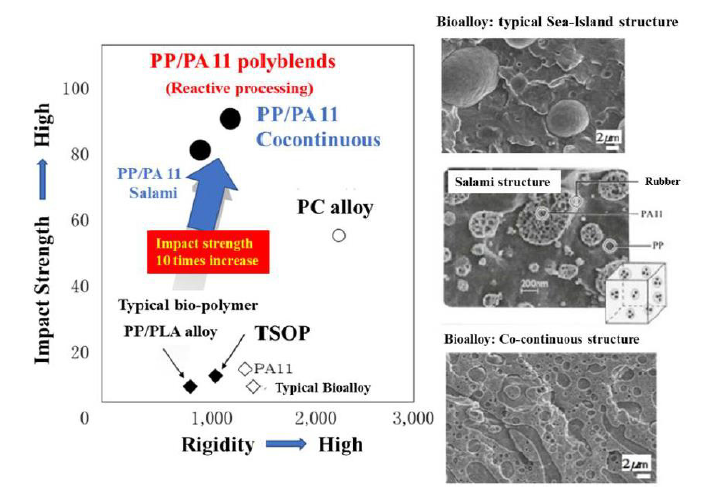
A New Compounding Technique (3) for NR/PP/NC Composites to Generate Fibrous Morphology
Blending of NR together with thermoplastics such as PP is practically attractive technology for developing new polymer composites such as thermoplastic vulcanizates which show synergistic performance together with rubber and thermoplastics [3]. A. Masa et al developed a new sophisticated compounding process concerning NR/PP/NC composites [4]. In this study, NR/PP blends with fixed content of NR/PP (80/20wt%) were prepared. PhOH and stannous chloride were used as curing agents. The results were also compared with those of the NR/PP blends without NC filling, NR filled with NC and pristine NR. Figure 4 shows stress-strain curves of these composites. It is obvious that the tensile stress level was greatly increased in case of the NR/PP/ NC composites.
Figure 4:Comparison of mechanical properties of various NR composites.

Figure 5:TEM images of NR/PP and NR/PP/NC composites.
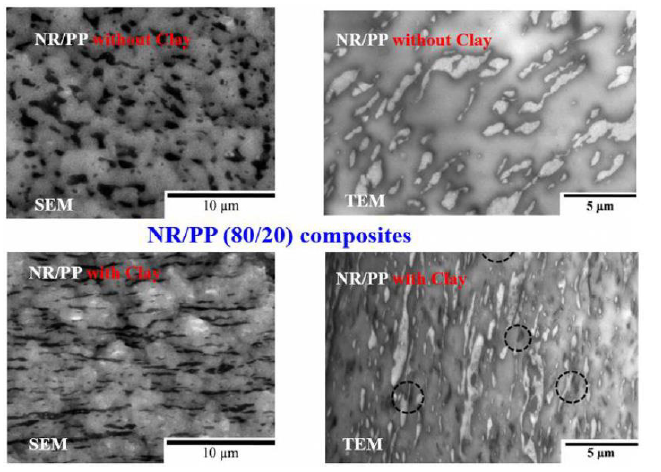
To analyze the reinforcement mechanism of the NR/PP/NC composites, Figure 5 shows TEM images of the NR/PP without NC composite and NR/PP/NC composite, respectively. The NR/ PP composite showed a typical dispersed PP phase within the NR matrix. However, in the NR/PP filled with NC, the PP domain was smaller, when compared with that of the NR/PP without NC and furthermore major proportions of the PP phase changed to fiberlike structure. The reason why the fibrous structure was generated is that the dispersed PP phases in the NR/PP/NC composite were deformed into the fiber-like structure by shearing force under the compounding temperature between melting point (Tm) and glass transition temperature (Tg) of PP. The key point of this compounding technique for the NR/PP/NC composites is the fact that the fibrous structure of the PP phases was maintained after the vulcanization of NR/PP/NC composites at high temperature above melting point of PP. This suggested that the NC addition and mechanical shearing during extrusion brought about the generation of the fibrous structure of the PP phases and further raised the drastic improvement in the reinforcement of the vulcanized composite.
In compounding processes of the composite, suspended NC (2 wt%) was first added into NR latex and was mixed under vigorous stirring at ambient temperature to obtain a NR/NC masterbatch with intercalated or exfoliated NC into the NR matrix. This mixing procedure for the NR latex and NC is well-known as a water-slurry compounding technique in the field of polymer nanocomposite processing [5]. The final content of NC in the NR/PP/NC composites was 5 phr. To remove water from the NR/NC slurry, so-called dewatering operation can be applied using twin screw extrusion [6]. After the NR/NC masterbatch was compounded with PP at 170 °C, the NR/PP/NC composites were mixed with PhOH and stannous chloride as curative agents at 120 °C, that is, the temperature between Tm and Tg of PP. Finally, the NR/PP/NC composites were statically vulcanized with hot-pressing at high temperature above Tm of PP to form a cured product. Based on these laboratory research results, a continuous compounding process using a twinscrew extruder was proposed by T. Sakai et al as shown in Figure 6 [7]. In this sophisticated compounding process using a twin-screw extruder, various compounding techniques are combined such as water-slurry mixing for the NR/NC, dewatering from the NR/NC slurry, melt mixing with NR and PP and fibrous PP phase formation. The compounding techniques shown in Figure 6 are available not only for NR latex but also other polymers.
Figure 6:A compounding process using twin screw extrusion for producing NR/PP/Clay composites.
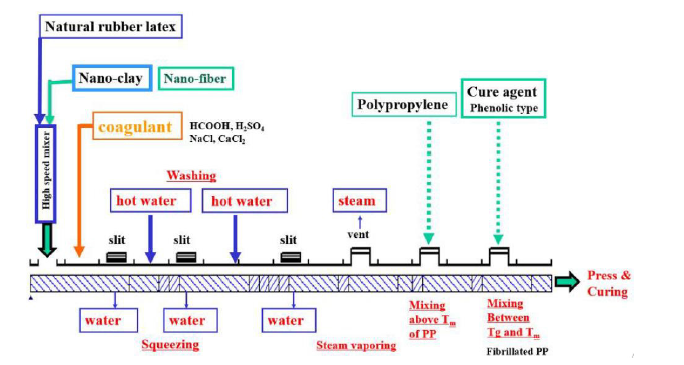
Conclusion
In this review three innovative compounding examples using sophisticated twin screw extrusion techniques were selected from the practical point of view. These techniques are related to nanofiller compounding, nano-scale polymer blending and combination of several compounding processes to produce fibrous morphology. These polymer composites and alloys developed in these studies are greatly expected to apply not only in the car industry, but also in other diversified areas.
Acknowledgement
None.
Conflict of Interest
No conflict of interest.
References
- T Morishita, Y Katagiri, T Matsunaga, Y Muraoka, K Fukumori (2017) Design and Fabricaation of Morphology Controlled Carbon Nanotube/Polyamide-6-Based Composites as Electrically Insulating Materials Having Enhanced Thermal Conductivity and Elastic Modulus. Composite Science & Technology 142: 41.
- J Kawada, M Kitou, M Mouri, T Mitsuoka, T Araki, et al. (2016) Morphology Controlled PA11 Bio-Alloys with Excellent Impact Strength. ACS Sustainable Chemical Engineering 4: 2158.
- N Lopattananon, S Tanglakwaraskul, A Kaesaman, M Seadan, T Sakai (2014) Effect of Nanoclay Addition on Morphology and Elastomeric Properties of Dynamically Vulcanized Natural Rubber/Polypropylene Nanocomposites. International Polymer Processing 29(3): 332.
- A Masa, H Saito, T Sakai, A Kaesaman, N Lopattananon (2017) Morphological Evolution and Mechanical Property Enhancement of Natural Rubber/Polypropylene Blend through Compatibilization by Nanoclay. J Applied Polymer Science 134: 44574.
- M Kato, M Matsushita, K Fukumori (2004) Development of a New Production Method for a Polypropylene-Clay Nanocomposite. Polymer Engineering & Science 44(7): 1205.
- T Sakai, N Hashimoto, K Kataoka (1993) Experimental Study on Dewatering and Devolatilization Operations Using Intermeshed Twin Screw Extruders. International Polymer Processing 8(3): 218.
- T Sakai, N Lopattananon (2022) Mixing and Compounding Techniques Using Twin Screw Extrusion. 37th Polym Proc Soc Annual Meeting Fukuoka, Preprint.
-
Tadamoto Sakai*. Recent Topics on Sophisticated Polymer Compounding Techniques Using Twin Screw Extrusion. Glob J Eng Sci. 10(2): 2022. GJES.MS.ID.000732.
-
Twin screw extruder, Compounding, Nano-filler, Polymer alloy, Composite, Morphology, Devolatilization
-

This work is licensed under a Creative Commons Attribution-NonCommercial 4.0 International License.






